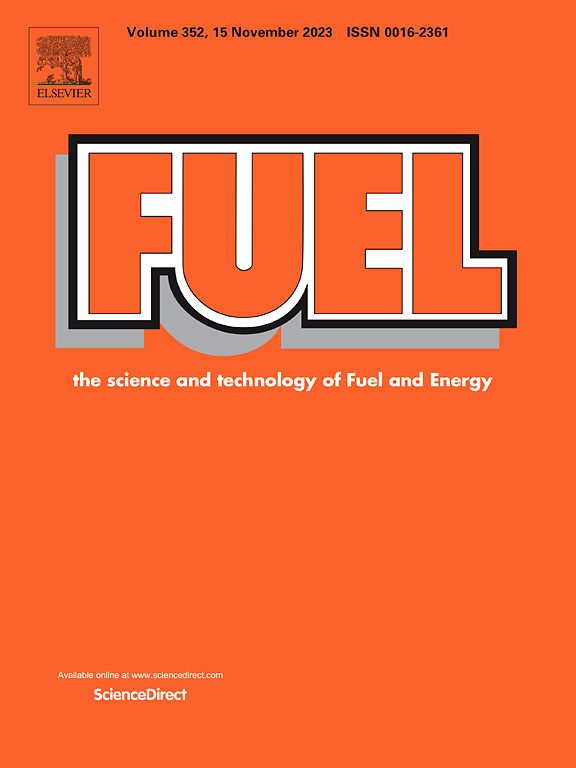注CO2对原油砂岩润湿性变化耦合效应的分子动力学模拟
IF 7.5
1区 工程技术
Q2 ENERGY & FUELS
引用次数: 0
摘要
本研究采用分子动力学模拟方法,分析了CO2饱和度、油相组成(n -十烷、混合沥青质油和纯沥青质油)、离子类型和浓度(NaCl、MgCl2、CaCl2)对碳酸化水-油-砂岩体系中SiO2表面润湿性的耦合影响。结果表明:在真空条件下,二氧化碳在碳酸水中的饱和度增加,导致CO2和H2O分子在SiO2表面竞争吸附,阻碍了水与SiO2表面羟基之间形成氢键,降低了水的润湿性。相反,在碳酸水-油-砂岩环境下,高沥青质含量降低了岩石表面对水的吸附能力,导致吸附的H2O分子数量减少,氢键减少,从而削弱了水的润湿性。但随着CO2饱和度的增加,溶解的CO2沿油水界面均匀分布,扰动H2O分子,增强其扩散,减少油分子在SiO2表面的聚集,使H2O穿透油膜,直接接触SiO2表面,从而增加氢键的形成和水的润湿性。在碳酸盐水-油环境下,二价阳离子Ca2+和Mg2+对润湿性的抑制作用强于一价阳离子Na+,特别是在高浓度Ca2+溶液中。Mg2+虽然降低了H2O的迁移率,但其强大的水化作用促进了SiO2表面的氢键,从而使润湿性优于Ca2+体系。因此,当向含盐含水层注入二氧化碳时,建议将含盐量和沥青质含量较低的储层作为目标,以最大限度地提高采收率。本文章由计算机程序翻译,如有差异,请以英文原文为准。
Molecular dynamics simulation of coupled effects of CO2 injection on wettability changes in crude oil-adsorbed sandstone
This research uses molecular dynamics simulations to analyze the coupled influences of CO2 saturation, oil phase composition (N-decane, mixed oil with asphaltenes, and pure asphaltenes), and ion types and concentrations (NaCl, MgCl2, CaCl2) on the water wettability of SiO2 surfaces in carbonated water–oil-sandstone systems. The results demonstrate that: under vacuum conditions, increasing CO2 saturation in carbonated water leads to competition between CO2 and H2O molecules for adsorption on SiO2 surfaces, hindering the formation of hydrogen bonds between water and hydroxyl groups on the SiO2 surface and reducing water wettability. In contrast, under carbonated water–oil-sandstone environments, higher asphaltene content diminishes water adsorption capacity on the rock surface, leading to a reduced number of adsorbed H2O molecules, fewer hydrogen bonds, and thus weakened water wettability. However, with increasing CO2 saturation, dissolved CO2 uniformly distributes along the oil–water interface, where it perturbs H2O molecules, enhances their diffusion, and reduces the aggregation of oil molecules on the SiO2 surface, making H2O penetrate the oil film and directly contact the SiO2 surface, thereby increasing hydrogen bond formation and water wettability. Under carbonated saline water–oil environments, divalent cations Ca2+ and Mg2+ exert a stronger inhibitory effect on wettability than monovalent cations Na+, particularly in high-concentration Ca2+ solutions. Although Mg2+ reduces H2O mobility, its strong hydration promotes hydrogen bonding on the SiO2 surface, resulting in better wettability than Ca2+ systems. Consequently, when injecting CO2 into saline aquifers, targeting reservoirs with lower salt and asphaltene contents is recommended to maximize enhanced oil recovery.
求助全文
通过发布文献求助,成功后即可免费获取论文全文。
去求助
来源期刊

Fuel
工程技术-工程:化工
CiteScore
12.80
自引率
20.30%
发文量
3506
审稿时长
64 days
期刊介绍:
The exploration of energy sources remains a critical matter of study. For the past nine decades, fuel has consistently held the forefront in primary research efforts within the field of energy science. This area of investigation encompasses a wide range of subjects, with a particular emphasis on emerging concerns like environmental factors and pollution.
 求助内容:
求助内容: 应助结果提醒方式:
应助结果提醒方式:


